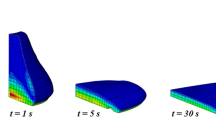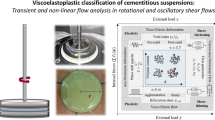Abstract
The rheology of concrete is influenced by water content, the amount, size and size distribution of all the solid components as well as by the dispersion of the finer particles through the addition of superplasticizers. In addition, the rheological behariour over time ovolves as a result of cement hydration. Consequently the a-priori prediction of concrete rheology is a complex task.
In this article, models that have been and are being developed to achieve this task are discussed. The key role of the degree of dispersion will be underlined. A treatment of interparticle forces and a yield stress model integrating these will be presented. Such work is necessary to integrate the dispersion efficiency of superplasticizers based on their dosage and molelar, structures into existing models for predicting concrete rheology.
Résumé
La rhéologie du béton est influencée par la teneur en eau, la quantité, la taille et la distribution de taille de tous les matériaux granulaires ainsi que du degré de dispersion qui peut être obtenu par l'ajout de superplastifiant. De plus, le comportement rhéologique de ce matériau évolue dans le temps à cause de l'hydration du ciment. Il en résulte que la prédiction de la rhéologie du béton est particulièrement complexe.
Dans cet article, des modèles existant et en cours de développment dont le but est précisément d'atteindre cet objectif sont discutés L'importance du degré de dispersion sera soulignée. Un traitement des forces interparticulaires et de leur lien au seuil d'écoulement est présenté. Le but d'un tel travail est de pouvoir en fin de compte inclure l'effet du dosage et de la structure moléculaire de superplastifiants dans les modèles existants pour la prédiction de la rhéologie du béton.
Similar content being viewed by others
References
De Larrard, F. and Sedran, T., ‘Mixture-proportioning of high-performance concrete’,Cem. Concr. Res. 32 (2002) 1699–1704.
Ambroise, J., Chabannet, M. and Péra, J., ‘Basic properties and effects of starch on self-levelling concrete’, Proceedings of the RILEM international symposium on the role of admixtures in high performance concrete (Ed. J. G. Cabrera and R. Rivera Villarreal), RILEM Publ., France, 357–376.
Wallevik, O., ‘Rheology of cement suspensions’, (The Icelandic Building Research Institute, 112 Keldnaholt, Iceland, 2002).
De Larrard, F., ‘Concrete mixture proportioning’ (E & FN Spon, London, 1999).
Van Damme, H. Mansoutre, S., Colombet, P., Lesaffre, C. and Picart, D., ‘Pastese: Lubricate and cohesive granular media’,C.R. Physique 3 (2002) 229–238.
Fernon, V., Vichot, A., Le Goanvic, N., Colombet, P., Corazza, F. and Costa, U., ‘Interaction between portland cement hydrates and polynaphtalene sulfonates’ in Proc. 5th Canmet/ACI Int. Conf. on Superplasticizers and Other Chemical Admixtures in Concrete (editor: Malhotra V.M.), (American Concrete Institute, Framington Hills, SP-173, 1997) 225–248.
Flatt, R.J. and Houst, Y.F., ‘A simplified view on chemical effects perturbing the action of superplasticizers’,Cem. Concr. Res. 31 (8) (2001) 1169–1176.
Flatt, R.J., ‘Interparticle, Forces in Cement Suspensions’, PhD Thesis 2040, 1999, EPEL, Switzerland.
Schober, I. and Maeder, U., ‘Compatibility of polycarboxylate superplasticizers with cement and cementitious blends’, in Proc. 7th Canmet/ACI Int. Conf. on Superplasticizers and Other Chemical Admixtures in Concrete, (editor: Malhotra, V.M.), (American Concrete Institute, Framington Hills, SP-217, 2003) 453–48.
Martys, N.S. and Mountain, R.D., ‘Velocity Verlet algorithm, for dissipative-particle-dynamics-based models of suspensions’,Phys. Rev. E. 59 (1999) 3733–3736.
Geiker, M.R., Brandl, M., Thrane, L.N. and Nielsen, L.F., ‘On the effect of coarse aggregate fraction and shape on the rheological properties of self-compacting concrete’,Cement and Concrete Aggreaties 24 (1) 3–6.
Ferraris, C.F. and Martys, N.S., ‘Relating fresh concrete viscosity measurements from different rheometer’,J. Res. Natl. Inst. Stand. Technol. 108 (2003).
Ferraris, C. and de Larrard, F., ‘Testing and modelling of fresh concrete rheology’, NISTIR 6094, National Institute of Standards and Technology, February 1998.
Tattersall, G.H. and Banfill, P.F., ‘The rheology of fresh concrete’ (Pitrnan advanced publishing program, London, 1983).
Schowalter W.R. and Christensen, G., ‘Toward a rationalization of the slump test for fresh concrete: Comparisons of calculations and experiments’,J. Rheol. 42, (4) (1998) 865–870.
Davidson, M.R., Khan, N.H. and Yeow, Y.L., ‘Collapse of a cyclinder of Bingham fluid’, ANZIAM J. 42 (E) pp. C499-C517, 2000, in Proceedings of the 1999 International Conference on Computational Techniques and Applications (CTAC-99).
Flatt, R.J. and Bowen, P., ‘Electrostatic, repulsion between particles in cement suspensions domain of validity of linearized Poisson-Boltzmann equation for non-ideal electrolytes’,Cem. Concr. Res. 2253 (2002) 1–11.
Flatt, R.J., ‘Dispersion forces in cement suspensions’,Cem. Concr. Res. 34 (3) (2004) 399–408.
Nachbaur, L., Mutin, J.C., Nonat, A. and Choplin, L., ‘Dynamic mode rheology of cement and tricalcium silicate pastes from mixing to setting’,Cem. Concr. Res. 31 (2001) 183–192.
Ramachandran, V.S., Malhotra, V.M., Jolicoeur, C. and Spiratos, N., ‘Superplasticizers: properties and applications in concrete’, (CANMET Publication MTL 97-14 (TR), Ottwa, Canada, 1998).
Flatt, R.J., ‘Polymeric Dispersants in Concrete’, in ‘Polymers in Particulate Systems: Properties and Applications’, Eds: Hackley, V.A., Somasundaran P., Lewis J.A., (Marcel Dekker, New York, 2001) 247–294.
Banfill, P.F.G., ‘A discussion of the paperRheological properties of cement mixes’ by M. Daimon and D.M. Roy,Cem. Concr. Res. 9 (1979) 795–798.
Daimon, M. and Roy, D.M., ‘Rheological properties of cement mixes I’,Cem. Concr. Res. 8 (1978) 753–764.
Gartner, E.M., Koyata, H. and Scheiner, P., ‘Influence of Aqueous Phase Composition on the Zeta Pontential of Cement in the presence of Water- Reducing Admixtures’, Ceramic Transactions (American Ceramic Society),40, (1994) 131–140.
Sakai, E. and Daimon M., ‘Mechanisms of superplastification’, in ‘Materials science of concrete IV’, Ed.: Skalny, J.P. and Mindess, S. (The American Ceramic Society, Westerville, OH, USA, 1995) 91–111.
Yoshioka, K., Sakai, E. and Daimon, M., ‘Role of steric hindrance in the performance of superplasticizers in concreté’,J. Am. Ceram Soc. (1997) 2667–2671.
Pedersen, H.G. and Bergström, L., ‘Forces between zirconia surfaces in poly(acrylic acid) solutions’,J. Am. Ceram. Soc.,82 (5) (1999) 137–1145.
Van Damme, H., ‘Colloidal chemo-mechanics of cement hydrates and smectice clays: cohesion, vs. Swelling’, in ‘Encyclopedia of surface and Colloidal Science’, (Marcel Dekker Inc, New York, 2002) 1087–1103.
Prieve, D.C. and Bevan, M.A., ‘Effect of physisorbed polymers on the interaction on latex particles and their dispersion stability’, in ‘Polymers in Particulate Systems: Properties and Applications’, Eds: Hackley, V.A., Somasundaran, P., and Lewis, J.A. (Marcel Dekker, New York, 2001) 1–26.
Yamada, K. and Hanehara, S., ‘Interaction mechanism of cement and superplasticizers—The roles of polymer adsorption and ionic conditions of aqueous phase’,Concrete Science and Engineering 3 (2001) 135–145.
Flatt, R.J., Houst, Y.F., Bowen, P., Hofmann, H., Widmer, J., Sulser, U., Maeder, U. and Bürge, T.A., ‘Interaction of superplasticizers with model poweders in a highly alkaline medium’ inProc. 5 th Canmet/ACI Int. Conf. on Superplasticizers and Other Chemical Admixtures in Concrete, Ed.: Malhotra V.M., (American Concrete Institute, Farmington Hills, Mi, USA, 1997, SP-173) 743–762.
Zhou, Z., Boger, D.V., Scales, P.J. and Healey, T.W., ‘Shear and compressional rheology principles in ceramic processing’ in ‘Polymers in Particulate Systems: Properties and Applications’, Eds.: Hackley, V.A., Somasundaran, P. and Lewis, J.A., (Marcel Dekker, New York, 2001) 157–195.
Flatt, R.J. and Bowen, P., Work in progress (2003).
Suzuki M. and Oshima T, ‘Estimation of the coordination number in a Multi-Component Mixture of Spheres’, Powder Technology35 (1983) 159–166.
Flatt, R.J., Ferrais, C., Martys, N. and Banfill, P., Workin in progres (2003).
Banfill, P.F.G., personal communication (2003).
Nolan, G.T. and Kavanagh, P.E., ‘The size distribution of interstices in random packings of spheres’,Powder Technology 78 (1994) 231–238.
Bowen, P., personal communication (2003).
Author information
Authors and Affiliations
Additional information
Editorial Note Dr. Robert J. Flatt presented a lecture of this paper at the 2003 RILEM Annual Meeting in Madrid, as he was awarded the 2003 Robert L'Hermite Medal in recognition of his work on cement and concrete technology. The L'Hermite Award Committee for 2003 decided to recommend the prize to Dr. Flatt since he has demonstrated original approach and independence for fundamental studies of issues which are relevant to cement and concrete technology. In particular he should be noted for his contributions to the basic understanding of the mechanisms of dispersants in concretes. His scientific work added valuable insight into chemical effect dispersants and their impact on, physical characteristics of particle interactions and rheology. His studies are highly valuable from a basic point of view and are bound to have practical implication. Dr. Flatt is a RILEM Senior Member.
Rights and permissions
About this article
Cite this article
Flatt, R.J. Towards a prediction of superplasticized concrete rheology. Mat. Struct. 37, 289–300 (2004). https://doi.org/10.1007/BF02481674
Received:
Accepted:
Issue Date:
DOI: https://doi.org/10.1007/BF02481674




